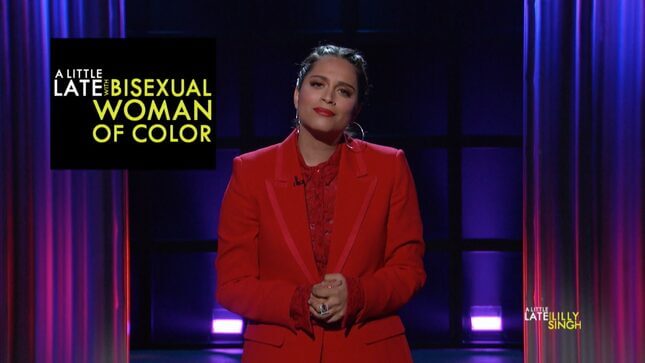

Much like red carpet interviews or going to the dentist, late night television has become something of a necessary evil (though the “necessary” qualifier is up for debate.) Stephen Colbert, Seth Meyers, Trevor Noah, John Oliver, James Corden, Jimmy Kimmel and Jimmy Fallon—or as I like to refer to all of them: the Jimmys—have laid claim to the nighttime talk show slots for years, inadvertently embodying all that is wrong with the format: it’s antiquated, formulaic, and so obviously dominated by white men (Noah’s the exception, but his show is lackluster, too.) So when Lilly Singh, veteran YouTuber, took on a new gig as the first ever bisexual Indian Canadian host of a late-night talk show, NBC’s A Little Late with Lilly Singh, there was reason to be excited. Her’s is a voice that’s gotten no space on primetime—there’s a reason she found and built her celebrity online—and judging by her first week of shows, she’s become stifled by the responsibility. That doesn’t mean it’s not a fun watch.
Singh’s show doesn’t differ much from the traditional late night format except in small, budgetary ways, which seems like a missed opportunity. In lieu of the Roots, Reggie Watts, or some other band of incredible instrumentalists, Singh has a DJ named Daniel. Instead of a show with two scheduled guests and a live act each night, Singh’s show differs from day to day—in her first week, she switched up from one guest to sometimes three, and there was one musical act: a performance by Australian boy band-turned-pop rock group 5 Seconds of Summer. Like other shows, her interviews are interspersed with comedic digital shorts, but they’re recycled throughout the week. Both Wednesday and Thursday night’s episodes included an unfortunately unfunny gag about FitBits for brown and black people, a response to a recent study that found some pedometers don’t accurately track the heart rate of people of color. The most obvious difference is that Singh’s show, unlike her male competition, is jam-packed with the ham-fisted progressive politics of social media activism. She opens with jokes about the “fear of white America,” when they realize they hadn’t tuned into “Slumdog Millionaire” while cheerleading her own success as the pinnacle of representation. She doesn’t dig any deeper. In fact, so far she’s sacrificed humor for entry-level wokeness.
She often sacrifices hum
In some situations, her sociopolitical posturing works (though, as she said in one of her recurring digital shorts, she will not spend any time talking about Donald Trump on the show); and in others, it’s forced. Her Monday nightdebut was by far the worst and most heavy-handed: before her first guest, Mindy Kaling, came out for an interview, Singh was joined by another The Office alumni, Rainn Wilson, and his “white noise machine,” a device that plays a variety of white people sounds like “Birkenstocks walking across the floor of an REI to buy a Patagonia jacket.” Instead of incisive commentary, it felt cringe-worthy and childlike—which, to be fair, is most of what YouTube is, anyway. Watching those gags on a linear network only serves to highlight the differences between the two formats.
But when her show works, it really works. Singh’s behind-the-scenes team is diverse, and for that reason, the writing has beautiful moments, much funnier than her late night counterparts. Her best opening monologue was on night two, when she joked about never receiving the sex talk from her immigrant parents and therefore assumed a man removes his dick before intercourse. “You should talk to your kids, or else there’s a good chance they’re learning about sex from Tyga,” she jokes. “I had to learn about sex the old-fashioned way, by watching a heavily edited version of American Pie on TV.” Later in the episode, she introduces a segment called “Gift Baskets,” where she ceremoniously offers presents to people in the public eye—beginning with Jussie Smollet, who gets a $100 subway gift card because he “never made it” and a wad of cash so the police can’t track him for his next staged hate crime, and Liam Hemsworth, who receives a mirror and Singh’s phone number. She also offers one to the “sad, sad virgins” who attended the Straight Pride Parade in Boston, full of sunscreen, a hat, and a dildo, to “suck it!” It’s genuinely fun and clever. In those scenes, her show excels.
But even when I’m back on board, Singh tends to get repetitive—she made a joke about her name being “bisexual woman of color late night talk show host” three times across four episodes, and it wasn’t even her best material. Then she’ll conduct the most delightful interview with Tracee Ellis Ross I’ve seen in a minute, and I’ll understand why she, of all famous internet celebrities, makes sense in this space. A Little Late with Lilly Singh is incredibly hit or miss, but the hits are good enough to keep you tuned in.The issue with making the move from YouTube to late night is that one is growing exponentially and the other feels dead in the water. Singh made a joke about it, suggesting that “if you don’t know me, your kids do,” and that “television is dying, the internet is thriving, so they brought me from the internet to—wait, was this a bad idea?” It was a gag, but also a glorious moment of unforced sincerity. She could very well be making a mistake. It’s much more likely that this show is doing more for her career than she is doing for it—it’s wonderful to see a woman of color occupy a time slot reserved for the same dudes named Jimmy, but it’s challenging to envision this disjointed program continuing on indefinitely like said Jimmys. The internet, however, will never die. And there is always YouTube.